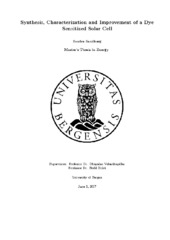| dc.description.abstract | Because of its light weight, low cost, flexibility and easy production techniques, Dye Sensitized Solar Cells (DSSCs) have become one of the promising PV-technologies for the future. Even though the DSSCs have been researched for over 20 years, the efficiencies reported are low compared to the commercial PV-cells of today, and further improvements have to be accomplished before DSSCs become a competitive technology. In this work DSSCs have been, for the first time, fabricated in its entirety at Western Norway University of Applied Sciences (HVL). As the synthesis of nanomaterials for the DSSCs and fabrication of DSSC are done for the first time locally, a large part of the work has been attributed to thoroughly document the procedure in the synthesis and fabrication processes. Variety of nanomaterial characterizations are done at UiB and the IV characterization of the fabricated DSSCs are done at HVL. The primary objective of this study is to establish a fabrication process for the DSSCs. In this study, a microwave-assisted method for synthesizing the semiconductor TiO2 nanostructures is applied, because this method reduces the synthesis time with up to 12 hours, compared to conventional methods like hydrothermal and sol-gel. XRD characterization of the nanostructures of TiO2 synthesized with the microwave-assisted method has revealed the desired anatase phase. The DSSCs produced with the same experimental procedure gave a range of different efficiencies, with the highest being (4.365±0.007)%. Even though the DSSCs fabricated in this study did not give the desired reproducibility through various tests and processes, the basic procedures for fabrication of DSSC have been established. The reason for lack of reproducibility is probably complex, but it is the author's viewpoint that the contributing factor is the technique used to paste the active TiO2 layer to the conductive glass, referred to as the doctor blade-technique. This coating is done manually and is difficult to standardize. An attempt has been done to standardize the procedures and suggestions are given for further improvements. As part of the desire to increase the efficiencies of the DSSCs, attempts are made to dope TiO2 with Fluorine and Nitrogen. Characterization of both the Nitrogen and Fluorine doped TiO2 samples show indication of doping, but this process needs further optimization. Studies carried out in this master project provides a foundation for further research on the synthesis of TiO2 based nanostructures with and without doping with external atoms, and fabrication techniques for DSSCs necessary for reproducibility and to enhance the efficiencies of DSSCs. | en_US |
